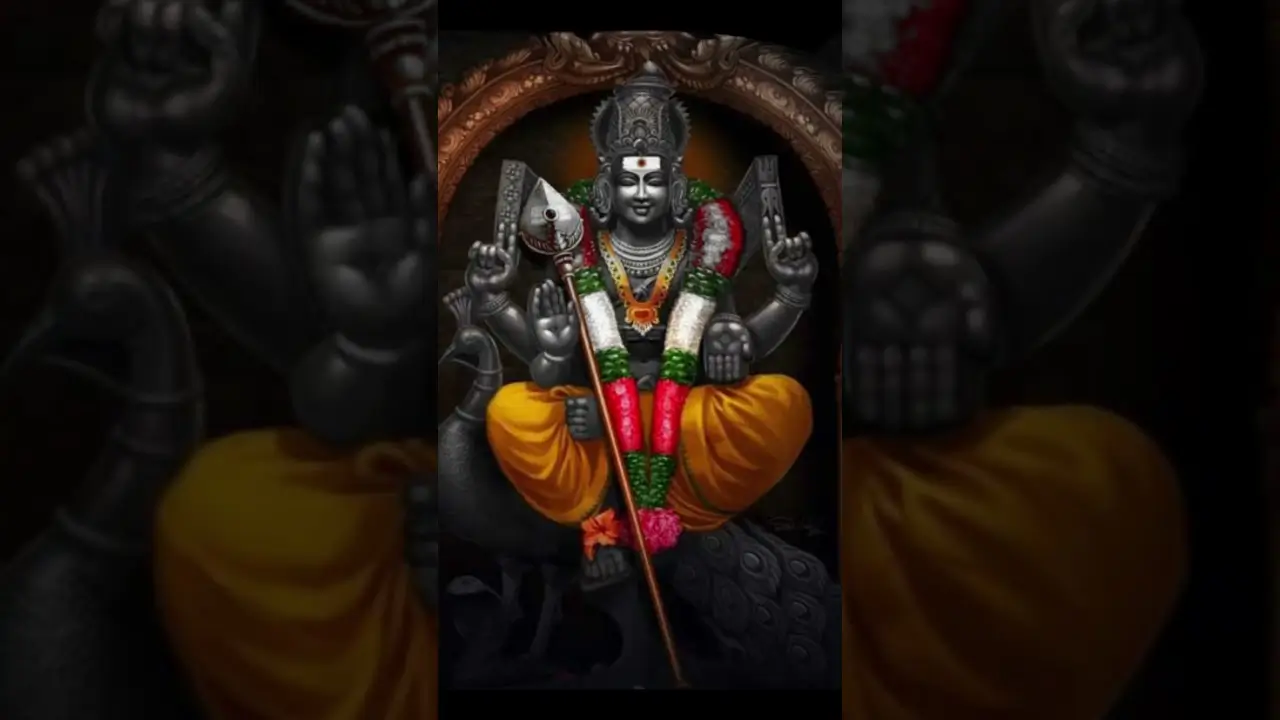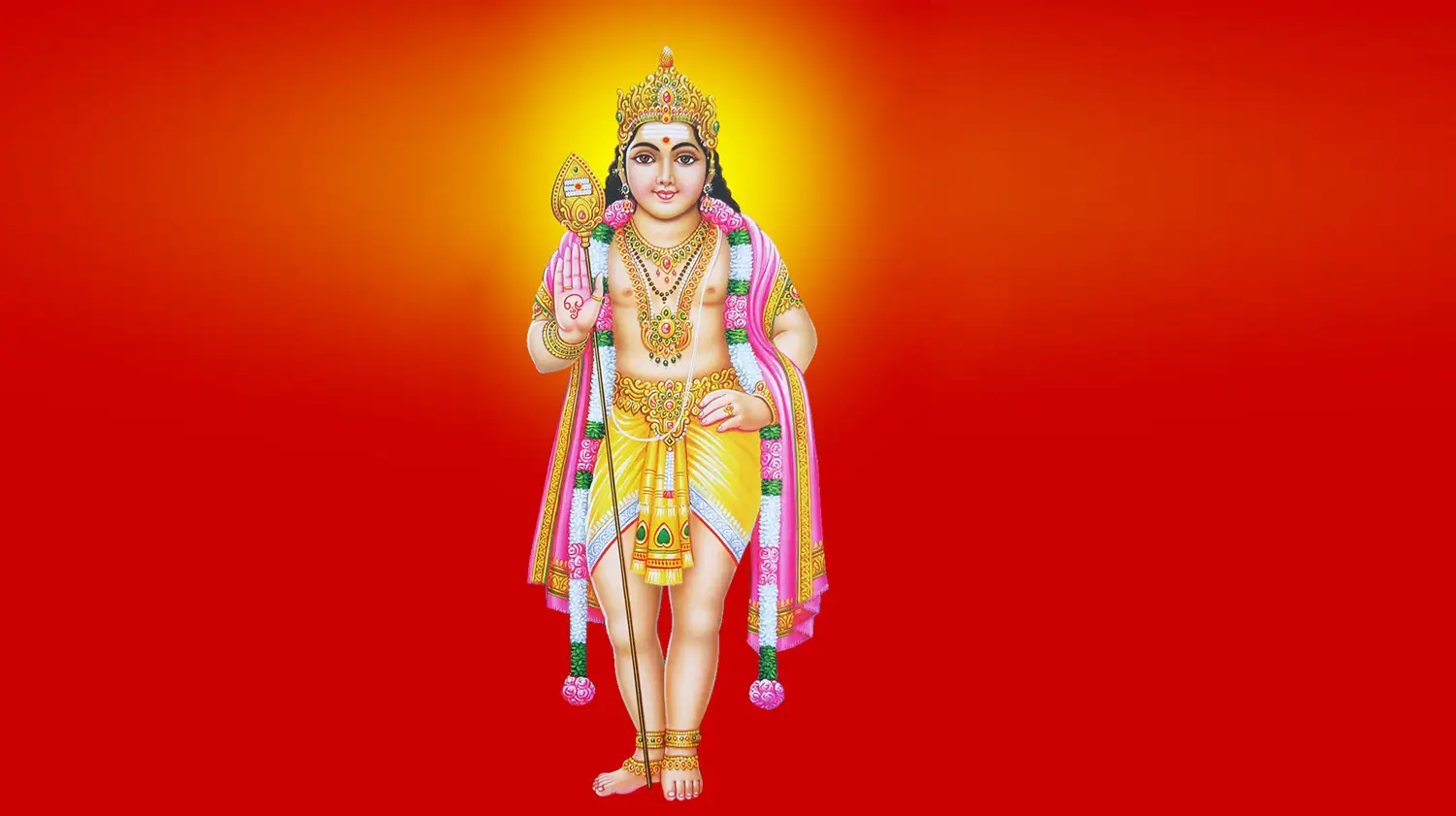Story of Lord Murugan

The Birth of Lord Murugan
The Devas (divine beings) approached Lord Shiva at Kailash, seeking his help to defeat the demon Tarakasura. Tarakasura had received a boon from Lord Brahma that he could only be killed by a son of Lord Shiva.
Moved by the Devas’ plight, Lord Shiva promised them that a child would be born to save them. It is believed that Lord Murugan was born from six sparks that emanated from Lord Shiva’s third eye. Agni (the Fire God) carried these sparks to a pond called Saravana, where six babies were born on lotus flowers. The six Kritikas, stars of the constellation Pleiades, nursed and raised the babies, which is why Lord Murugan is also known as Kartikeya (“Son of the Kritikas”). When Parvati and Shiva arrived, Parvati embraced all six babies, merging them into one being with six heads.
The Devas celebrated the birth of this child, and once he grew up, he was appointed as their commander-in-chief.
The Story of the Golden Mango
One day, while relaxing on Mount Kailash with his wife Parvati and their sons Ganesha and Murugan, Lord Shiva received a visit from Sage Narada, who presented him with a golden mango. Narada explained that this mango was no ordinary fruit; it was the golden mango of knowledge, granting eternal wisdom to whoever ate it.
As a loving husband, Shiva gave the mango to Parvati, who wanted to share it with their children. Since the fruit couldn’t be divided, they announced a contest: whoever completed three rounds of the world first would receive the mango.
Murugan swiftly mounted his peacock and set off to circle the world. Meanwhile, Ganesha walked around his parents three times. Confused, Shiva and Parvati asked Ganesha why he was circling them instead of the world. Ganesha replied, “You, my parents, are my universe and my whole world. Circling you is the same as circling the entire world.” He finished his third circle just as Murugan returned from his journey.
Upon learning that Ganesha had won, Murugan felt cheated and, in anger, renounced his family. He settled on what is now known as Palani Hill. Shiva and Parvati came to console him, saying, “Pazham Nee” (meaning “You are the Fruit”), which led to the name Palani.
Lord Murugan Becomes the Guru
When Murugan was a young child, his father Shiva sent him to receive education from Lord Brahma. Murugan asked Brahma, “Please tell me the meaning of Om.” Brahma responded, “First learn the alphabets! You are directly asking for the meaning of Om.” Murugan insisted, “No, I want to know the highest knowledge first – Om.”
Although Brahma knew all about the alphabets, he did not know the meaning of Om (the primordial sound). Murugan said, “You do not know the meaning of Om. How will you teach me? I will not study under you.” He returned to Shiva, who was informed by Brahma about the situation. Brahma admitted, “You alone can handle your son. I can’t teach him; he contradicts everything I say.”
Shiva asked Murugan, “What happened, son? Lord Brahma is the Creator of the entire universe. You must learn from him.” Murugan replied, “Then you tell me, what is the meaning of Om?” Shiva smiled and said, “Even I don’t know.”
Murugan then offered, “I will tell you because I know the meaning of Om. But I can’t tell you like this. You have to give me the place of the Guru. Only if you put me on the pedestal of the Guru can I tell you.” A Guru must be on a higher position, with the student sitting below.
So Shiva lifted the young Murugan onto his shoulders. Murugan then whispered the meaning of the Pranava Mantra (Om) into Shiva’s ear, explaining that the entire Creation is contained within Om. The Trinity – Brahma, Vishnu, and Shiva – are contained in Om. Om signifies unbroken and unshakeable love, which is the essence and the secret of Om that Murugan revealed to Shiva.
Kartikeya’s Divine Weapon: The Vel
As Kartikeya grew, he was endowed with extraordinary powers and prepared for his divine mission. One of the most significant gifts he received was the Vel, a powerful spear, given to him by his mother Parvati. The Vel symbolized divine protection, courage, and the power to destroy evil. It became Kartikeya’s primary weapon in his battle against Tarakasura.
The Battles with Tarakasura
With the Vel in hand, Kartikeya led the divine forces against Tarakasura and his demon army. The battles were fierce and prolonged, marked by several key confrontations:
Initial Confrontation: Kartikeya’s first encounter with Tarakasura’s forces was a test of his strategic and combat skills. Using the Vel, he demonstrated his divine prowess, vanquishing many demons and boosting the morale of the Devas.
The Siege of the Demon Fort: Tarakasura had fortified himself in an impregnable fortress. Kartikeya, with his sharp intellect and the divine guidance of the Vel, devised a plan to penetrate the defenses. He led a daring siege, using the Vel to break through the barriers and defeat the formidable guards.
The Final Battle: The ultimate confrontation between Kartikeya and Tarakasura was a grand and intense battle. Tarakasura, confident in his boon, fought ferociously. However, Kartikeya, empowered by the divine energy of the Vel, proved to be an unstoppable force. In a climactic duel, Kartikeya hurled the Vel with immense power and precision, piercing Tarakasura’s heart and ending his reign of terror.
The Aftermath and Legacy: The defeat of Tarakasura marked a significant victory for the Devas, restoring peace and order to the heavens. Kartikeya, hailed as the commander-in-chief of the divine army, became a revered deity symbolizing bravery, protection, and the triumph of good over evil.
The Vel, as his divine weapon, became an emblem of his victory and divine authority. It is venerated in temples and festivals dedicated to Lord Kartikeya, known as Murugan in South India, where devotees celebrate his valor and seek his blessings for courage and protection.
The stories of Kartikeya’s battles with Tarakasura and the symbolism of the Vel continue to inspire and resonate with devotees, embodying the eternal struggle between good and evil and the ultimate triumph of righteousness.

Tamil Kadavul Murugan
Saint Avvaiyar, Arunagirinathar, and Pamban Swamigal: Devotees of Lord Murugan
Saint Avvaiyar: Saint Avvaiyar, a revered Tamil poet-saint, was a devoted follower of Lord Murugan. Known for her wisdom and simplicity, her poetry often praises Murugan’s virtues. One famous tale describes Murugan, disguised as a young boy, testing her humility and revealing deep spiritual truths.
Arunagirinathar: Arunagirinathar, a 15th-century saint, transformed his life after a divine intervention by Murugan. He composed the “Tiruppugazh,” a collection of hymns dedicated to Murugan. These hymns, known for their poetic beauty and complex rhythms, celebrate Murugan’s divine attributes and victories.
Pamban Swamigal: Pamban Swamigal, a 19th-century saint, is renowned for composing the “Kandha Sashti Kavacham,” a powerful hymn seeking Murugan’s protection and blessings. This hymn is especially recited during the six-day Kandha Sashti festival, commemorating Murugan’s victory over the demon Surapadman.
Worship and Devotion
Festivals and Rituals Honoring Lord Murugan: Devotees celebrate Murugan’s victory over Tarakasura with elaborate festivals and rituals, including Thaipusam and Skanda Shasti. These vibrant celebrations are marked by devotional songs, processions, and offerings of fruits and flowers.
Pilgrimages to Sacred Sites: Sacred sites dedicated to Murugan, such as the Aru Padaiveedu temples in Tamil Nadu, India, Nallur Kandhan temple in Jaffna, Sri lanka attract millions of pilgrims each year. These devotees seek Murugan’s blessings and guidance, undertaking arduous journeys to express their devotion and gratitude.
Devotional Practices and Offerings: Devotees offer prayers, hymns, and sacred chants to Murugan, seeking his protection and blessings in all aspects of life. They present offerings of fruits, sweets, and flowers as tokens of their love and reverence for the divine warrior.
Legacy and Reverence
Impact on Hindu Culture and Tradition: Murugan’s story continues to inspire and captivate people of all ages and backgrounds. His divine grace and wisdom permeate Hindu culture and tradition, shaping beliefs, rituals, and festivals for millennia.
Symbolism and Significance in Modern Times: In addition to his role as a warrior and protector, Murugan symbolizes resilience, courage, and spiritual awakening. His imagery and teachings resonate with people seeking guidance and inspiration in an ever-changing world.
Eternal Inspiration for Seekers of Truth and Justice: As the embodiment of divine grace and valor, Murugan remains a beacon of hope and inspiration for seekers of truth and justice. His timeless teachings and virtues continue to guide humanity on the path of righteousness and enlightenment.
